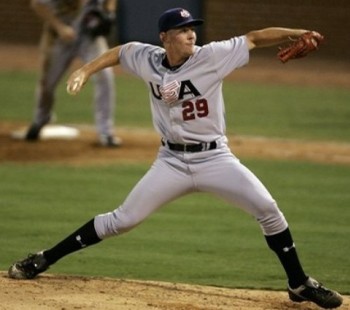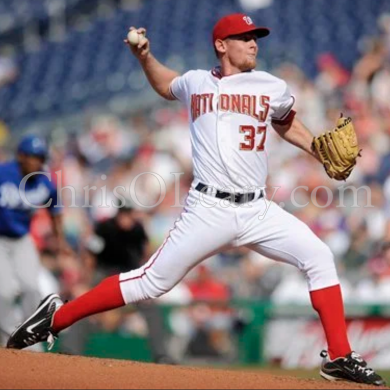|
 The
Inverted W,
and its contribution to pitching injuries and the epidemic, remains
controversial, despite its proven power when it comes to predicting pitcher injuries. The
Inverted W,
and its contribution to pitching injuries and the epidemic, remains
controversial, despite its proven power when it comes to predicting pitcher injuries.
Tom House and his apologists, and now the folks at Driveline — who
are pushing their
Elbow Spiral — are doing their best to convince you
to
pay no attention to that man behind the curtain.
So who and what should you believe?
I'd suggest you start with
what Eric Cressey, now of the New York Yankees,
said about the Inverted W way back in 2012...
The Inverted W theory is incredibly sound; Chris O'Leary
did a tremendous job of making his case – and we certainly work to
coach throwers out of this flaw...
In this piece, I touch on a number of the most important aspects of the Inverted W...
Inverted W: An Overview
The Inverted W is a particularly problematic arm action that is employed by
many frequently injured pitchers.
- Michael Fulmer
- Mark Prior
- Anthony Reyes
- Stephen Strasburg
Definition
The Inverted W is defined as the pitcher...
- Lifting their elbows to the point
where they are at, or even above, the level of their shoulders.
- While, and more importantly, their forearms are flat or, worse yet, pointing downwards.
- Into, or in the worst case at, Foot Plant and/or the start
of shoulder rotation.
Biomechanically speaking, that means bilateral
hyperabduction
and minimal external rotation, or worse prolonged internal rotation,
of both arms into Foot Plant.
Problem
The Inverted W is a problem when — as it so often, but not
always, does — it creates a
Timing problem.
Timing
While Stephen Strasburg's arm action was scary...

Stephen Strasburg
Inverted W
...what
convinced me Strasburg was heading for problems, and what got his arm, was the Timing problem it created.

Stephen Strasburg
Timing Problem
See how, as Stephen Strasburg's shoulders are starting to turn,
his pitching arm is FLAT and not UP.
That's bad.
Mark Prior of the Cubs is another prominent pitcher who employed
the Inverted W.

Mark Prior
Inverted W
And whose career was ended by the Timing problem created by his
Inverted W.
For those who don't know whether to believe the Tom House
apologists, when they blame the Marcus Giles collision for Mark
Prior's injury problems — after which Mark Prior got BETTER,
not worse — I ask you this.
What happened to Anthony Reyes?

Anthony Reyes
Inverted W
Michael Fulmer
Michael Fulmer of the Tigers is a contemporary pitcher who
employs the Inverted W and who needed Tommy John surgery, I'd argue as
a result.

Michael Fulmer
Inverted W
And what first gets the Elbow, then tends to get the Shoulder.
Chris Sale
Chris Sale was widely said to employ the Inverted W, but actually didn't.
Until Sale joined the Red Sox and they decided to boost his velocity by
creating an (actual) Inverted W.
Hyperabduction
A key feature of, and problem with, the Inverted W is
Hyperabduction; the taking of the elbows above the level of the
shoulders. That will...
- Increase the distance the pitching arm has to
travel to get UP.
- Tend to increase the likelihood a pitcher will have a
Timing problem.
It may also cause impingement injuries and other shoulder problems.
The Inverted W isn't (that) bad in and of itself. Rather it is
problematic because it can — and tends to — create a Timing
problem in pitchers who employ it.
Can.
Tends to.
But not always does.
That's a point I first made in September 2007 in my
analysis of Mark Prior's pitching mechanics.
In Frame 28, Mark Prior is at a position that I call the Inverted W (or simply
The M). Notice how his PAS elbow is
both above and behind his shoulders and his PAS forearm is hanging
down nearly vertically beneath it.
This position isn't damaging in and of itself.
However, by coming to this position, Mark Prior is
ensuring that his pitching arm will not be in the proper position
at the moment his shoulders start to turn.
As with pitchers with other timing problems like rushing,
because his pitching arm is so late, he will dramatically increase
the stress on both his elbow and shoulder.
Cressey
As for some of the details of
what Eric Cressey, now of the New York Yankees, said about the Inverted W in 2012.
First, a lot of guys still throw with the
Inverted W and don't have significant arm issues (or any whatsoever)
As I've said, the Inverted W is only a problem if it creates a
Timing problem,
which it usually, but doesn't always, does. There's also the fact
that many pitchers who are labeled as having the Inverted W and/or
Timing problems -- starting with Chris Sale, with the White Sox,
don't actually.
Second, a lot of guys who don't have an Inverted
W still wind up with elbow or shoulder injuries.
I've never claimed the Inverted W is the ONLY reason why pitchers
get hurt. There are other ways pitchers can develop Timing problems,
including the
Tommy John
Twist and the
Elbow Spiral.
Again, my concern with the Inverted W is that that it very
reliably, but not always, creates Timing problems in baseball
pitchers.
And, remember, Timing is what matters, ultimately, when it comes
to pitcher injuries and health.
|


 The
The



